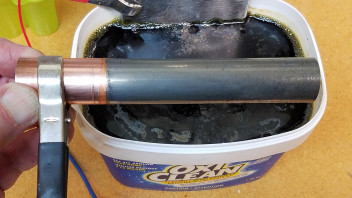Hi All,
My first post - I
assembled a LEC to try to replicate a version of the Frank Gordon,
Harper Whitehouse
experiment.
- WE 22.2 mm OD,
140mm long copper pipe, roughed up to a shine with medium steel wool
- plated in Ferrous
Sulphate 125 gr, Sodium Citrate 125 gr, household ammonia cleaner 350 gr,
1.5 litre of tap water, heavy steel plate Anode with mill scale
ground off
- ~200 mA for 6
hours formed a well adhered grey coat, a magnet is attracted to the iron
coating
- Outer electrode
was a black iron pipe nipple 27mm ID, mill scale on ID removed with
brake cylinder hone to a shine
- WE insulated with
o rings at each end to prevent shorting and thoroughly dried
- cell capacitance
measured at 55.5 pf, cell resistance > 100 Megohm
- Voltage measured
with Fluke model 83 multi meter 10 Megohm input resistance. Meter on mV
range, .1 mV resolution
- 1 Megohm resistor across cell as a load
Observations: no
voltage reading within +- .1 mV was observed during a 6 hour run
At this point on a
hunch I placed one small drop of the electrolytic solution on
the top o ring so that it bridged the WE and the outer electrode and
immediately saw ~200 mV on the meter which was still present after
one hour. In a later test, a droplet placed on the bottom of the cell
showed a voltage (~25mV) and over 2 minutes the voltage swung slowly
from positive to negative, perhaps as the droplet was moving from
iron to copper scratches on the WE?
I wonder if some of
the electrolyte solution could become entrapped in a heavy iron
coating and be released later causing false positives in some
experiments? I noticed some of the coatings from other attempts are heavy and flaky and show odd reddish craters.


